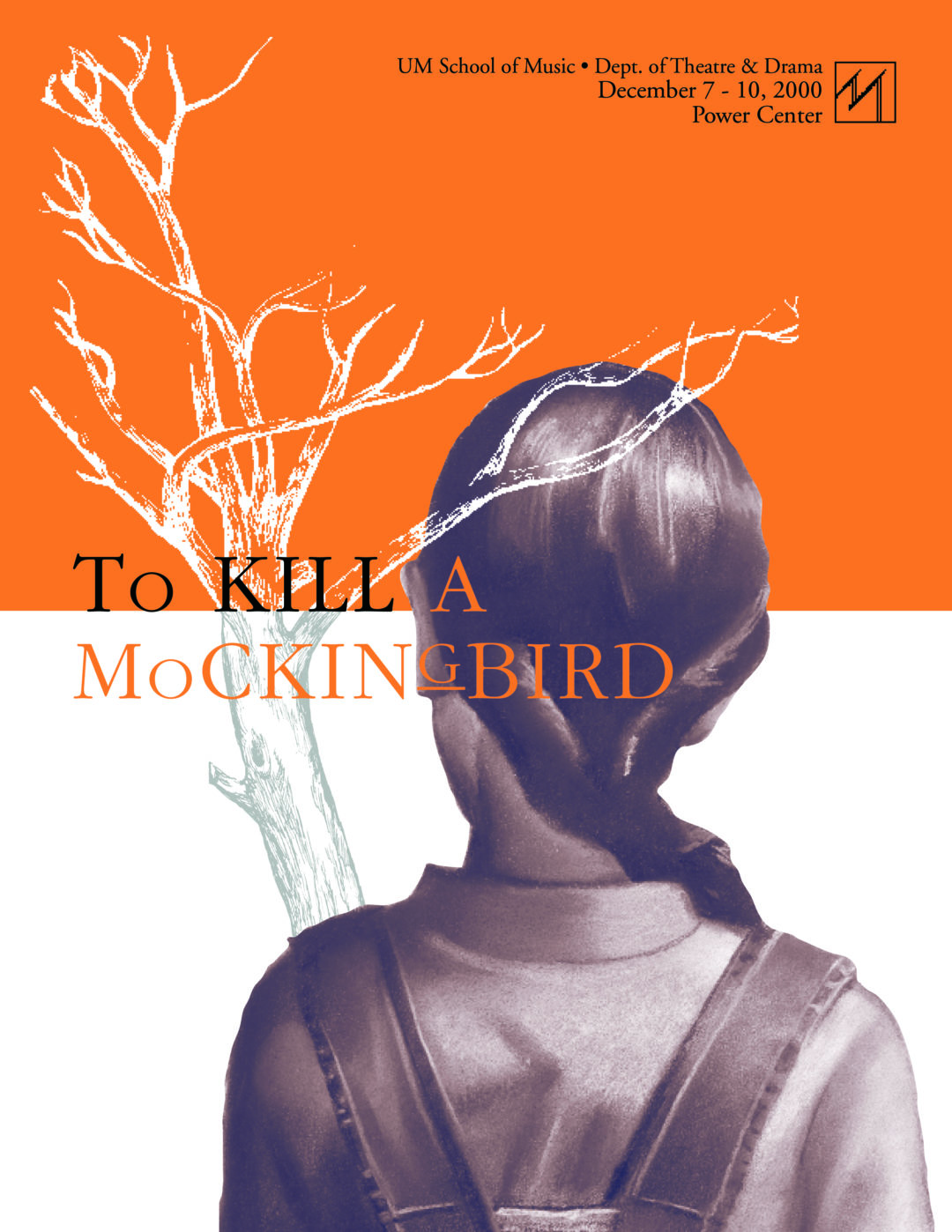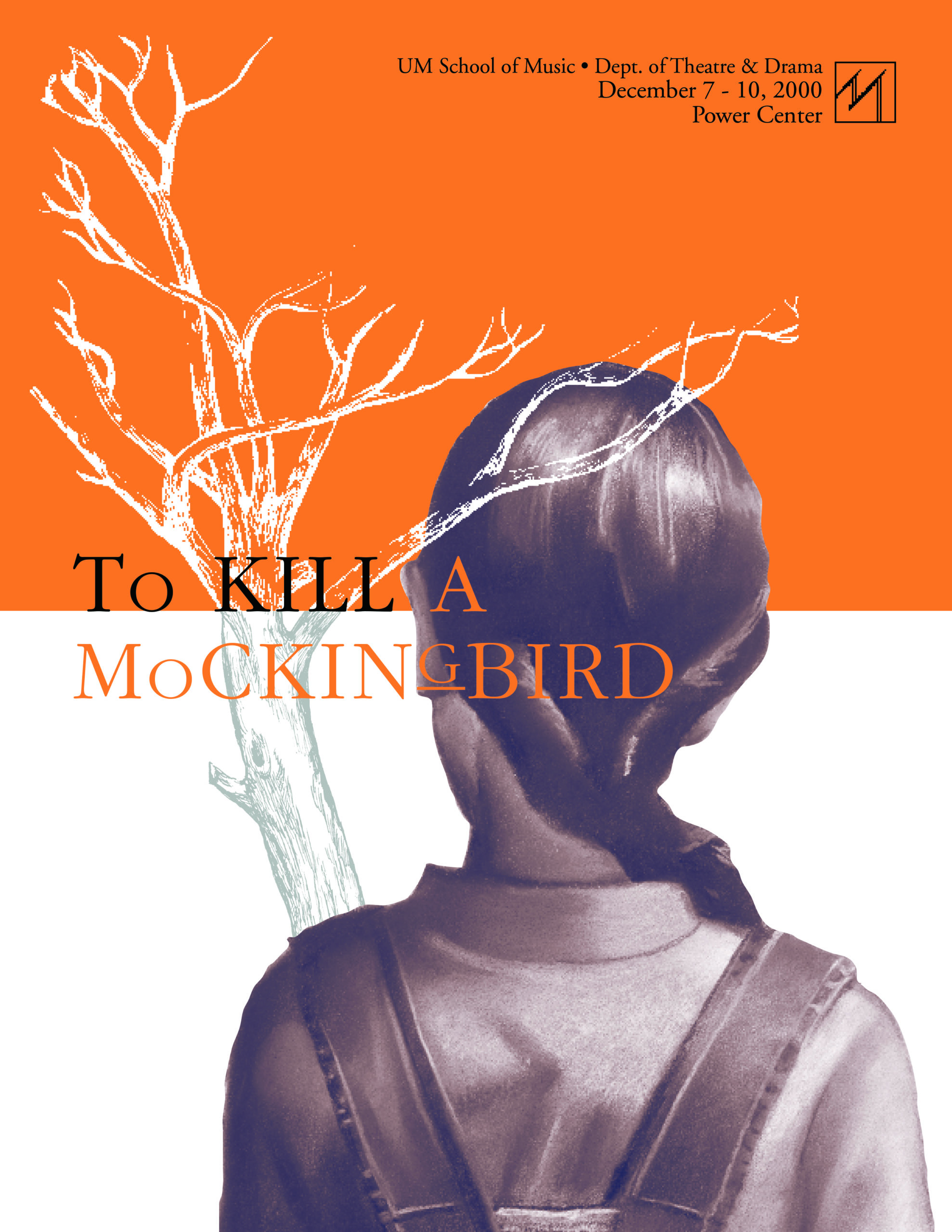To Kill a Mockingbird
Adapted by Christopher Sergal
From the novel by Harper Lee
Department of Theatre & Drama
December 7-10, 2000 • Power Center
To Kill a Mockingbird is the only novel by Harper Lee. Born in 1926 in Alabama, Lee’s childhood bears many similarities to Scout, the central character of Mockingbird, although it is not autobiographical. Lee drew on her own experience as a young girl in the South to create a rich atmosphere filled with the distinct voices of the people in the town of Maycomb. The novel was published in 1960 and quickly garnered acclaim, winning the Pulitzer Prize for Fiction in 1961, making Lee the first woman to win the award since 1942. The story was turned into a movie in 1962, starring Gregory Peck as Atticus Finch and winning numerous awards of its own. Dramatized for the stage by Christopher Sergel in 1970, the play is continuously produced throughout the county, including an annual production in Lee’s hometown of Monroeville, Alabama. The dramatization retained more of the original novel’s prose than the movie, which provide rich descriptive elements necessary for the theatrical requirements of live production.
Told through the perspective of eight-year old Scout, “To Kill a Mockingbird” is set in a small Southern town during the Depression. She and her brother Jem are being raised by their widower father Atticus and by a strong-minded housekeeper Calpurnia. Wide-eyed Scout is fascinated with the people of her small town, but from the start, there’s a rumble of thunder just under the calm surface of the life here. The black people of the community have a special feeling for Scout’s father and she doesn’t know why. A few of her white friends are inexplicably hostile and Scout doesn’t understand this either. Atticus, a lawyer, explains that he’s defending a young Negro wrongfully accused of a grave crime. Since this is causing such an upset, Scout wants to know why he’s doing it. “Because if I didn’t,” her father replies, “I couldn’t hold my head up.” Atticus’s reply to Scout underscores the central theme of the play: the ability to put oneself in another’s shoes in an effort to recognize truth.
Artistic Staff
Director: Kathryn Long
Scenic Designer: Gary Decker
Costume Designer: Jessica Hahn
Lighting Designer: Harold F. Burgess II
Sound Designer: Henry Reynolds
Vocal Coach: Annette Masson
Stage Manager: Patrick K. A. Elkins
Cast
Jean Louise Finch: Alexa Ouellett
Scout, Jean’s younger self: Taryn Fixel
Calpurnia, the housekeeper: Cortney Wright
Miss Maudie Atkinson, a neighbor: Sandra Abrevaya
Miss Stephanie Crawford, a neighbor: Michelle Alizabeth Roberts
Mrs. Dubose, a neighbor: Jennifer Lima
Jessie, her attendant: Rachel Easley
Jem, Scout’s brother: Benjamin Klein
Reverend Sykes, minister: Kevin Bradley Jr.
Dill, Scout and Jem’s friend: Maggie Smythe
Nathan Radley, a neighbor: David Jones
Atticus Finch, Scout and Jem’s father: Anthony von Halle
Walter Cunningham, a farmer: Ethan B. Kogan
Heck Tate, the sheriff: Dan Hall
Mr. Gilmer, public prosecutor: Quinn Strassel
Judge Taylor: Matthew H. Urban
Bob Ewell, Mayella’s father: Dan Granke
Mayella Ewell, a young woman: Lauren Spodarek
Tom Robinson, a young man: Boyd White III
Helen Robinson, Tom’s wife: Grace Edwards
Link Deas, Tom’s employer: Jason Smith
Court Clerk: Joseph A. Hendrix
Boo Radley, a recluse: David Jones
Sponsors
The School of Music acknowledges the generosity of McKinley Associates, Inc. whose support has helped make this production possible.
Resources
[accordion title=”Director’s Notes”]
To Kill a Mockingbird has made enormous and lasting impressions as both a book and a film. What remains to be explored in a theatrical adaptation? Can this tale, set literally a lifetime ago, retain the ability to engage us now?
I think it can, although undoubtedly for somewhat different reasons than it might have when the book (and film) appeared in the early 1960s or when the play was first produced in the early 70’s. For those of us who can remember those eras, we know our culture has changed significantly – not least in the laws and social mores related to race. Compared to 1935, I suspect it is fair to say that we live in a different world. Do these changes reduce To Kill a Mockingbird to “feel good” nostalgia, a cautionary lesson that preaches to the (mostly) converted?
I don’t think so. For me, the play distills the heart of Lee’s book. Beneath the particular circumstances of the crisis that envelopes Scout’s family and neighbors lies a timeless struggle between two perspectives: acting in accordance with one’s own convictions; and standing in someone else’s shoes.
Atticus teaches his children both concepts, although in their purest forms they are antithetical. The Tom Robinson case tests his ability to truly live, in the chaos of the world, by navigating between these two principles. It is the balancing act between knowing when to view the world from another’s perspective and when to stick with your own vision that challenges not only the inhabitants of Maycomb, but each of us.
As we explored the world of Mockingbird in rehearsal, some of the details of the characters’ lives seemed strange, but the chaos was familiar. Atticus’ principles were a compass and a challenge. I hope they engage you too.
— Kathryn Long
[/accordion]


